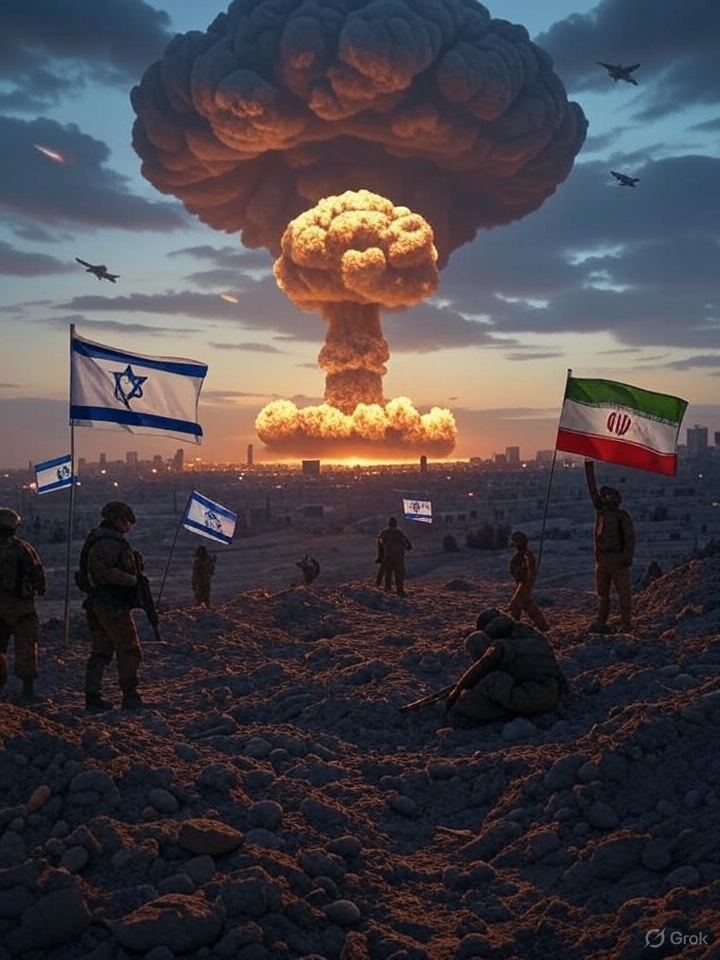During the early months of his second term, President Trump resisted Israel’s growing push for an assault on Iran’s nuclear program. But as war broke out, Trump’s position began shifting, caught between his campaign promises, Israeli pressure, and the complex realities on the ground. Now, with the conflict intensifying, he is seriously weighing whether to involve the U.S. military.
For weeks, senior Trump administration officials tried to hold back Israeli Prime Minister Benjamin Netanyahu’s growing determination to strike. Despite Israeli claims, U.S. intelligence officials saw no new evidence that Iran was rushing to build a nuclear bomb that would justify a pre-emptive attack. Nevertheless, Trump’s team recognized they might not be able to stop Netanyahu this time. Meanwhile, Trump himself was growing increasingly frustrated with the stalled negotiations with Iran and began to doubt the talks would lead anywhere.
Faced with dwindling options, Trump’s advisers considered a range of responses. On one end was a hands-off approach: allowing events to unfold and reassessing once Israel’s attack had played out. On the other was full military cooperation with Israel — potentially even leading to regime change in Iran.
Ultimately, Trump opted for a middle ground. He offered undisclosed intelligence support to Israel, helping them carry out their initial strikes, while simultaneously escalating pressure on Tehran to make rapid concessions at the negotiating table or face further military escalation.
Now, five days into Israel’s offensive, Trump’s stance continues to evolve. Initially, the administration publicly distanced itself from Israel’s actions. But as Israel demonstrated early military success, Washington’s tone shifted to a more supportive one. Trump is now seriously considering sending American aircraft to assist in refueling Israeli jets and deploying 30,000-pound bunker-buster bombs to target Iran’s deeply buried Fordo nuclear facility — a stunning reversal from his opposition to military action just two months prior.
This dramatic chain of events reveals the complex dynamic between Trump and Netanyahu. While both leaders share the ultimate goal of preventing Iran from acquiring nuclear weapons, mutual mistrust has long clouded their relationship. Publicly, they speak often of their strong personal and political bond, but behind the scenes, tensions simmer.
Interviews with two dozen officials across the United States, Israel, and the Persian Gulf paint a portrait of a president grappling with his first major foreign policy crisis of his second term. Surrounded by an inner circle of loyal but relatively inexperienced advisers, Trump struggled for months to contain Netanyahu’s hawkish instincts. At one point, he confided to a political ally that Netanyahu was trying to “drag him into another Middle East war” — exactly the kind of entanglement he vowed during his campaign to avoid.
In the early months of his second term, President Trump resisted Israel’s growing push for a military strike against Iran’s nuclear program. But as events unfolded, his position shifted dramatically under increasing pressure from both Israeli Prime Minister Benjamin Netanyahu and his own frustrations with stalled diplomatic efforts.
For months, Trump’s administration tried to rein in Netanyahu’s determination to launch a preemptive attack, despite lacking any new intelligence indicating that Iran was racing to build a nuclear weapon. U.S. intelligence assessments continued to show that while Iran was enriching uranium, it had not yet made the decision to weaponize its nuclear program — a key threshold for triggering military intervention.
But Trump grew increasingly convinced that Iran was playing him at the negotiating table, much like he felt Russian President Vladimir V. Putin had done during earlier attempts to broker a cease-fire and peace deal in Ukraine. Disillusioned with the slow pace of diplomacy, Trump began to believe that direct action might be the only way to force Iran into concessions.
When Israel finally chose war, Trump’s stance shifted once again. He wavered between skepticism about getting too closely tied to Netanyahu’s campaign and gradually edging toward direct U.S. military involvement — even as many of his advisers continued to believe that Iran posed no immediate nuclear threat.
The shift was on full display as Trump returned abruptly from a Group of 7 summit in Canada. Speaking to reporters, he publicly pushed back against the testimony of his own Director of National Intelligence, Tulsi Gabbard, who had stated that the intelligence community did not believe Iran was actively building nuclear weapons. “I don’t care what she said,” Trump declared. “I think they were very close to having them.”
Faced with mounting pressure, Trump ultimately chose a middle path: quietly providing Israel with intelligence support to enable its strike, while preparing to escalate militarily if necessary. Now, with the conflict intensifying, Trump is seriously considering deploying American aircraft to refuel Israeli jets and potentially using bunker-buster bombs to target Iran’s underground Fordo nuclear facility — a stunning reversal from his opposition to military involvement just weeks earlier.
This unfolding crisis highlights the complicated relationship between Trump and Netanyahu — two leaders aligned in their objectives but wary of each other’s motives. While both are united in their desire to prevent a nuclear-armed Iran, deep-seated mistrust and political calculations continue to shape their decisions behind the scenes.
For Prime Minister Netanyahu, the past several months marked the culmination of years spent trying to persuade the United States to support — or at least tolerate — his long-standing ambition to deliver a crippling blow to Iran’s nuclear program. In the end, he appears to have correctly calculated that President Trump would eventually align with him, even if reluctantly.But beyond the mounting casualties and destruction, the crisis has also exposed growing divisions within Trump’s own party. On one side are those who instinctively rally to defend Israel, America’s closest ally in the region. On the other are voices increasingly wary of dragging the United States deeper into yet another Middle Eastern conflict — a cycle of violence many believe America should avoid.
The events leading up to Israel’s strike reveal a complex story of two leaders — President Trump and Prime Minister Netanyahu — who share a common objective: preventing Iran from acquiring a nuclear weapon. Yet, despite their frequent public displays of political and personal solidarity, deep mistrust has long underscored their relationship.
Interviews with over two dozen officials from the United States, Israel, and the Persian Gulf region paint a picture of Trump vacillating for months, unsure how best to rein in Netanyahu’s aggressive instincts as he faced the first major foreign policy crisis of his second term. Surrounded by an inner circle largely chosen for their loyalty rather than their foreign policy experience, Trump navigated the escalating crisis with caution and uncertainty.
Privately, he confided to a political ally that Netanyahu was attempting to pull him into another Middle East war — exactly the kind of entanglement Trump had pledged to avoid during his presidential campaign just a year earlier.
President Trump’s advisers had been bracing for this moment. By late May, intelligence reports indicated that Israel was preparing to launch a major assault on Iran, seemingly determined to proceed regardless of the diplomatic path Trump was still pursuing with Tehran
In response to these developments, Vice President J.D. Vance and Marco Rubio — serving in his joint role as secretary of state and national security adviser — pushed for a comprehensive planning effort. Their goal was to present the president with a clear range of options, allowing him to make swift decisions if U.S. involvement became necessary.
Under the direction of John Ratcliffe, intelligence-gathering efforts intensified. In the two weeks leading up to a critical meeting at Camp David, Trump’s top advisers met repeatedly to coordinate and finalize the menu of possible actions the United States might take.
Then, on Monday, June 9 — the day after the Camp David meeting — Trump spoke directly with Netanyahu by phone. The Israeli leader was blunt and unequivocal: the operation was moving forward.
According to three people familiar with the call, Netanyahu outlined his plans in broad terms, making it clear that Israeli forces were already operating on the ground inside Iran.
Trump was impressed by the sophistication and boldness of the Israeli military planning. While he made no immediate commitments during the call, after hanging up, he confided to his advisers, “I think we might have to help him.
Still, Trump wrestled with the decision throughout the week, repeatedly consulting his advisers. He had always intended to handle Iran on his own terms — not to be drawn into Netanyahu’s agenda — and maintained confidence in his ability to negotiate a deal. But over time, he became increasingly convinced that Tehran was simply stringing him along.
Unlike some members of the anti-interventionist wing of his party, Trump never believed the United States could tolerate and contain a nuclear-armed Iran. He shared Netanyahu’s view that a nuclear Iran posed an existential threat to Israel. As Trump told his aides, Netanyahu was determined to do whatever was necessary to protect his country — and might not wait for U.S. approval to act.

